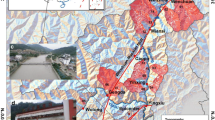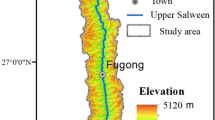Abstract
Debris flow susceptibility is usually evaluated through material supplies and topographic features and the formation of debris flow is ascribed to the factors over the whole valley, almost ignoring detailed distribution of material sources and variety of behaviors in different tributaries. So far, there is not a comprehensive picture of debris flow developing from source tributaries to mainstream channel. Debris flow in Jiangjia Gully (JJG) exhibits diversity of surges and vivid scenarios concerning the forming and developing mechanisms. This study takes JJG as an example to explore how the materials are distributed in the valley and how the spatial heterogeneity of material distribution and tributary evolution influence the forming of variety of debris flow surges. It is found that most materials are distributed in tributaries of active stages with evolution index between 0.55 and 0.65; the occurrence of debris flow relies more on the spatial distribution of source tributaries than on the quantity of the material. Local conditions of tributaries, such as the concentration of materials, the granular structure of soils, and the locations receiving frequent rainfalls, are the very factors governing a debris flow event. It is the spatial heterogeneity of sources and material supplies that result in the variety of debris flow surges in JJG. Similar mode is believed to occur in debris flows in other regions.




















Similar content being viewed by others
References
Arattano M, Marchi L (2000) Video-derived velocity distribution along a debris flow surge. Phys Chem Earth (B) 25(9):781–784
Blackwelder E (1928) Mudflows as a geologic agent in semiarid mountains. Bull Geol Soc Am 39:465–484
Blahut J, van Westen CJ, Sterlacchini S (2010) Analysis of landslide inventories for accurate prediction of debris-flow source areas. Geomorphology 119:36–51
Broscoe AJ, Thompson S (1969) Observations on an alpine mudflow, Steel Creek, Yukon. Can J Earth Sci 6:219–229
Caine N (1980) The rainfall intensity-duration control of shallow landslides and debris flows. Geografiska Annaler Ser A Phys Geogr 62:23–27
Chen N, Han W, He J, Yan H (2001) Gravity-driven debris flows in a small gully in the northeast Tunnan. Journal of Mountain Science 19(5):418–421 (In Chinese)
Chen H, Lee CF (2000) Numerical simulation of debris flows. Can Geotech J 37(1):146–160
Crowley JK, Hubbard BE, Mars JC (2003) Analysis of potential debris flow source areas on Mount Shasta, California, by using airborne and satellite remote sensing data. Remote Sens Environ 87(2):345–358
Cui P, Chen XQ, Wang YY, Hu KH, Li Y (2005) Jiangjia Ravine debris flows in south-western China. In: Jakob M, Hungr O (eds) Debris-flow hazards and related phenomena. Springer, Praxis, pp 565–594
Davies TR, Phillips CJ, Pearce AJ, Zhang XB (1991) New aspects of debris flow behavior. In: Proceedings, U.S.-Japan workshop on snow avalanches, landslides, debris flows prediction and control, Tsukuba, Japan, pp 443–451
Davies TR, Phillips CJ, Pearce AJ, Zhang X (1992) Debris-flow behavior–an integrated overview. In: Proceedings, international symposium on erosion, debris flow and environment in mountain regions, IAHS Publication, Chengdu, China. No. 206, pp 217–226
Dong JJ, Lee CT, Tung YH (2009) The role of the sediment buget in understanding debris flow susceptibility. Earth Surf Process Landforms 34(2):1612–1624
Du RH, Kang ZC, Chen XQ (1987) Investigation and prevention planing of debris flows in Xiaojiang River, Yunnan. Chongqing Branch of Science and Technology Literature Press, Chongqing (In Chinese)
Fannin RJ, Wise MP (2001) An empirical-statistical model for debris flow travel distance. Can Geotech J 38:982–994
Garcia-Davalillo J, Herrera G, Notti D, Strozzi T, Alvarez-Fernandez I (2014) DInSAR analysis of ALOS PALSAR images for the assessment of very slow landslides: the Tena valley case study. Landslides 11:225–246
Gonzalez-Diez A, Fernandez-Maroto G, Doughty MW, Diaz de Teran JR, Bruschi V, Cardenal J, Perez JL, Mata E, Delgado J (2014) Development of a methodological approach for the accurate measurement of slope changes due to landslides, using digital photogrammetry. Landslides 11:615–628
Gou WC, Li Y, Wang BL, Liu DC (2015) Grain composition and soil strength of debris flows in Jiahe Gully. Sci Technol Eng 15(35):136–140 (In Chinese)
Guo XJ, Cui P, Li Y, Ma L, Ge YG, Mahoney WB (2016a) Intensity-duration threshold of rainfall-triggered debris flows in the Wenchuan Earthquake affected area, China. Geomorphology 253:208–216
Guo XJ, Li Y, Cui P, Zhao WY, Jiang XY, Yan Y (2016b) Discontinuous slope failures and pore-water pressure variation. J Mount Sci 13(1):116–125. https://doi.org/10.1007/s11629-015-3528-4
Guzzetti F, Peruccacci S, Rossi M, Stark C (2008) The rainfall intensity–duration control of shallow landslides and debris flows: an update. Landslides 5:3–17
Iverson RM, Reid ME, Iverson NR, LaHusen RG, Logan M, Mann JE, Brien DL (2000) Acute sensitivity of landslide rates to initial soil porosity. Science 290:513–516. https://doi.org/10.1126/science.290.5491.513
Iverson RM (2014) Debris flows: behavior and hazard assessment. Geol Today 30(1):15–20
Iverson RM, George DL (2016) Modelling landslide liquefaction, mobility bifurcation and the dynamics of the 2014 Oso disaster. Geotechnique 66:175–187
Kappes MS, Malet JP, Remaitre A, Horton P, Jaboyedoff M, Bell R (2011) Assessment of debris-flow susceptibility at medium-scale in the Barcelonnette Basin. France Nat Hazards Earth Syst Sci 11:627–641
Li Y, Liu JJ, Hu KH, Su PC (2012) Probability distribution of measured debris-flow velocity in Jiangjia Gully, Yunnan Province, China. Nat Hazards 60(2):689–701
Li Y, Liu J, Su F, Xie J, Wang B (2015a) Relationship between grain composition and debris flow characteristics: a case study of the Jiangjia Gully in China. Landslides 12:19–28. https://doi.org/10.1007/s10346-014-0475-z
Li Y, Wang BL, Zhou XJ, Gou WC (2015b) Variation in grain size distribution in debris flow. J Mount Sci 12:682–688. https://doi.org/10.1007/s11629-014-3351-3
Li Y, Zhou X, Su P, Kong Y, Liu J (2013) A scaling distribution for grain composition of debris flow. Geomorphology 192:30–42. https://doi.org/10.1016/j.geomorph.2013.03.015
Li J, Luo DF (1981) The formation and characteristics of mudflow and flood in the mountain area of the Daqiao River and its prevention. Z Geomorph N F 25(4):470–484
Li J, Yuan J, Yuan JM, Bi C, Luo DF (1983) The main features of the mudflow in Jiangjia Ravine. Z Geomorph N F 27(3):325–341
Li Y, Yue ZQ, Lee CF, Beighley RE, Chen X-Q, Hu K-H, Cui P (2009) Hack's law of debris-flow basins. Int J Sediment Res 24:74–87. https://doi.org/10.1016/S1001-6279(09)60017-2
Li Y, Hu K, Yue ZQ, Tham TG (2004) Termination and deposition of debris-flow surge. In: Lacerda W, Ehrlich M, Fontoura SA, Sayao AS (Eds) Landslides: evaluation and stabilization. 2004 Taylor & Francis Group, London, pp 1451–1456
Limerinos J (1970) Determination of the manning coefficient from measured bed roughness in natural channels. Technical report, USGS Water Supply Paper 1898-B
Lorente A, Begueria S, Bathurst JC, Garcia-Ruiz JM (2003) Debris flow characteristics and relationships in the Central Spanish Pyrenees. Nat Hazards Earth Syst Sci 3:683–691
Major JJ (1997) Depositional processes in large-scale debris-flow experiments. J Geol 105:345–366
Monin AS, Yaglom AM (1975) Statistical fluid mechanics, vol 2. MIT Press, Cambridge Mass
Nakata AM, Matsushima T (2014) Landslide simulation based on particle method: toward statistical risk evaluation. COMPSAFE2014, pp 397–399
Pierson TC (1980) Erosion and deposition by debris flows at Mt. Thomas, North Canterbury. N Z Earth Surf Process 5:227–247
Pierson TC (1986) Flow behavior of channelized debris flowss, Mount St. Helens, Washington. In: Abrahams AD (ed) Hillslope Processes (The Binghamton Symposia in Geomorphology: International Series, No. 16), Allen and Unwin, Inc., pp 269–296
Qiao JP, Huang D, Yang ZJ, Meng HJ (2012) Statistical method on dynamic reserve of debris flows source materials in meizoseismal area of Wenchuan earthquake region. Chin J Geol Hazard Control 23(2):1–6 (in Chinese)
Rickenmann D (1999) Empirical relationships for debris flows. Nat Hazards 19:47–77
Rickenmann D, Laigle D, Mcardell BW, Hubl J (2006) Comparison of 2D debris-flow simulation models with field events. Comput Geosci 10:241–264
Rickmers WR (1927) The duab of turkestan. Cambridge University Press, Cambridge
Royan MJ, Abellan A, Jaboyedoff M, Vilaplana JM, Calvet J (2014) Spatio-temporal analysis of rockfall pre-failure deformation using Terrestrial LiDAR. Landslides 11:697–709
Santi PM, Dewolfe VG, Higgins JD, Cannon SH, Gartner JE (2008) Sources of debris flow material in burned areas. Geomorphology 96(3–4):310–321
Sharp RP (1953) Mudflow of 1941 at Wrightwood, southern California. Geol Soc Am Bull 64:547–560
Sharp RP (1942) Soil structures in the St. Elias Range, Yukon Territory. J Geomorphol 5:274–301
Shieh CL, Jan CD, Tsai YF (1996) A numerical simulation of debris flow and its application. Nat Hazards 13:39–54
Strahler AN (1952) Hypsomic analysis of erosional topography. Bull Geol Soc Am 63:1117–1142
Strahler AN (1957) Quantitative analysis of watershed geomorphology. Eos Trans Am Geophys Union 38:913–920
Takahashi T (2007) Debris flow mechanics, Prediction and Countermeasures. Taylor & Francis/Balkema, Milton Park
Takahashi T (1991) Debris flow. IAHR/AIRH Monography Series. A. A Balkeman, Rotterdam
Tian LQ (1987) Geomorphology and debris flow of Jiangjia Gully. J Mount Sci 5(4):203–212 (In Chinese)
Tunusluoglu MC, Gokceoglu AC, Nefeslioglu AHA, Sonmez AH (2008) Extraction of potential debris source areas by logistic regression technique: a case study from Barla, Besparmak and Kapi mountains (NWTaurids, Turkey). Environ Geol 54:9–22
Wang B, Li Y, Gou W, Guo C, Yao L (2017) Fine grain migration and its impact on soil failures under rainfall infiltration. Adv Eng Sci 49(Supp. 2):40–50 (In Chinese)
Wu JS, Kang ZC, Tian LQ (1990) Observation and study of debris flows in Jiangjia Gully, Yunnan. Science Press, Beijing (in Chinese)
Yang RW (1997) Solid material supplied volume to debris flow in Jiangjia ravine, Yunnan province. J Mount Res 15(4):305–307
Acknowledgements
This study is supported by the Strategic Priority Research Program of the Chinese Academy of Sciences (Grant no. XDA230902) and the Key International S&T Cooperation Projects (Grant no. 2016YFE0122400).
Author information
Authors and Affiliations
Corresponding author
Additional information
Publisher's Note
Springer Nature remains neutral with regard to jurisdictional claims in published maps and institutional affiliations.
Rights and permissions
About this article
Cite this article
Xiafei, T., Fenghuan, S., Xiaojun, G. et al. Material sources supplying debris flows in Jiangjia Gully. Environ Earth Sci 79, 318 (2020). https://doi.org/10.1007/s12665-020-09020-4
Received:
Accepted:
Published:
DOI: https://doi.org/10.1007/s12665-020-09020-4




